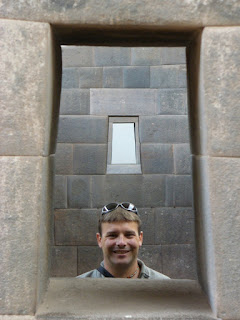We reached Cusco by train on November 6. Our journey started from Puno, nestled on the shores of Lake Titicaca and was quite simply an experience to remember. We upgraded our tickets to First Class and travelled for ten hours in total luxury through picture-perfect plains, valleys and mountain passes. Each train carriage was a refurbished wood-panelled Orient Express-style affair, complete with a glass wall and glass roof observation deck at the back of the train.
On our first night in town, we tried a Tapas restaurant called Cicciolina. It had been recommended by Matthew, a friend from Sydney. We loved it! The bar was kitted out with bundles of hanging garlic, onions, chilli peppers and other dried goods, while the food itself was the closest thing to heaven found in South America. We duly recommended it to the rest of our tour group.
Our first full day in Cusco was largely spent out of town visiting Sacsayhuaman and the Sacred Valley. Sacsayhuaman is an enormous fortress, come Inca temple, high on the hills overlooking Cusco. The foundations are the only remains but what a sight they are. Individual stones in the foundation walls are up to four metres high, and support a series of three receding terraces. The longest of the three retaining walls is about 400 metres, while the highest walls rise about six metres.
Sadly, after conquering the area, the Spaniards began to use Sacsayhuamán as a source of stones for building Spanish Cuzco. Within a few years, they'd taken apart and demolished much of the complex. It was sad to think that so many of the Spanish governmental and religious buildings we'd admired in the colonial city below had come from such an impressive structure.
Pisac in Sacred Valley was equally memorable. We visited the local market while in full swing and took many colourful photos. The market is renowned for its miniature guinea pig castles. Here our furry friends live in multi-storied mansions while awaiting their fate as tomorrow's meal. Guinea pig is a delicacy in Peru and everyone seems to enjoy growing their own no matter where you go, or how poor they may be.
Garry and I both tried Guinea Pig but have to admit that it's full of bones and tastes like old mutton. It's also just a little off-putting to be presented with the plate containing a flat, four-pawed animal, looking more like fresh roadkill than a tasty meal.
It was fascinating to watch a debate unfold among our tour group over the use of coca tea. Several members objected to its consumption on ethical grounds. Given that we were using it in a purely medicinal form, and in its natural state, I found their stance rather extreme.
On a slightly more dubious note, it would be fair to say that we enjoyed the local cocktail, Pisco Sour, a little more liberally. We seemed to be greeted with a small sour wherever we went - and we were always more than happy to oblige. Here's a demonstration by Garry.























No comments:
Post a Comment